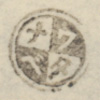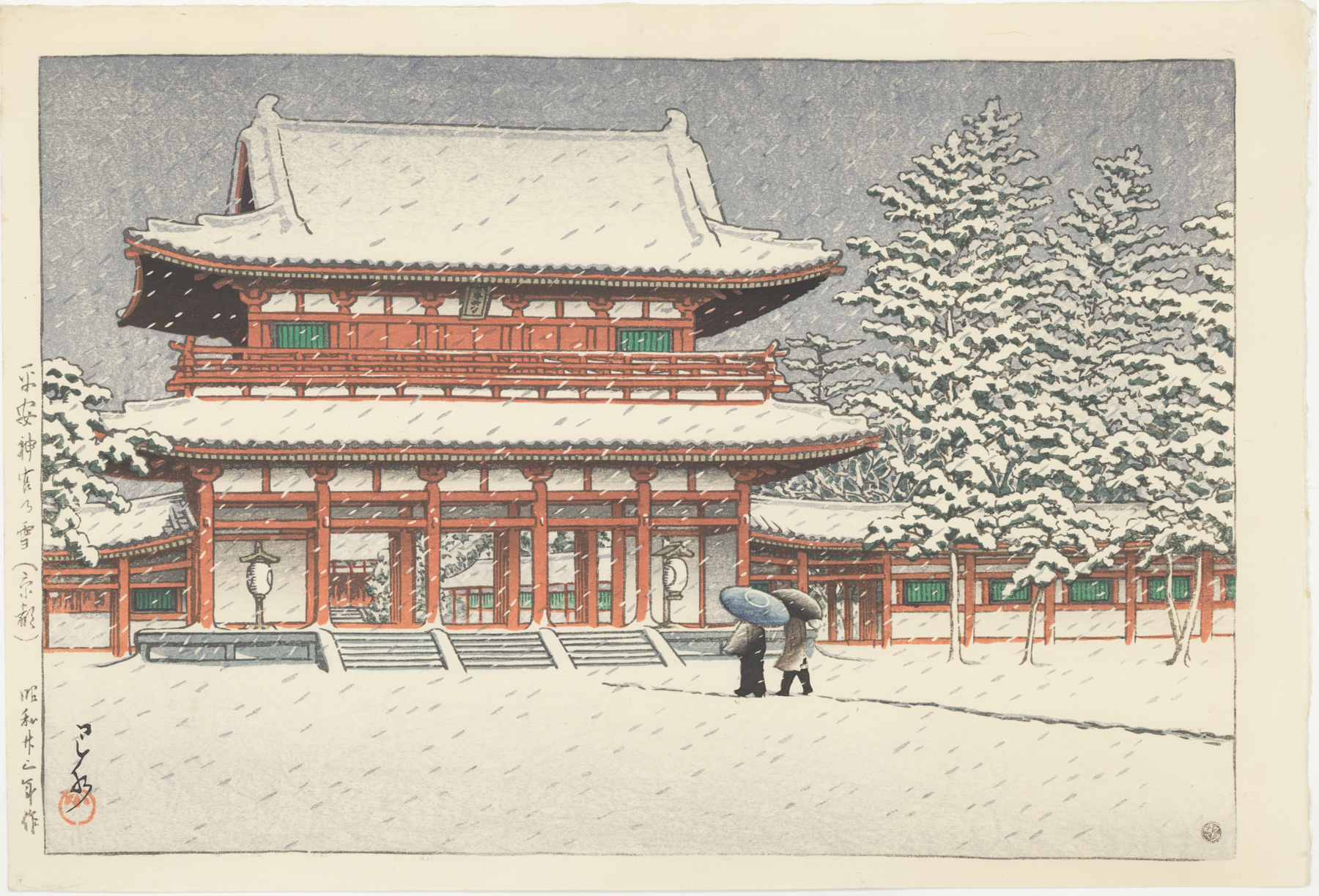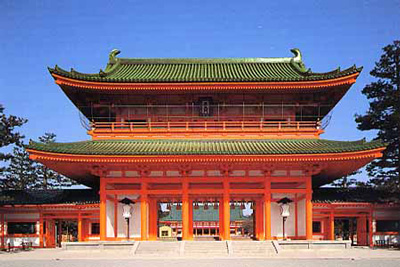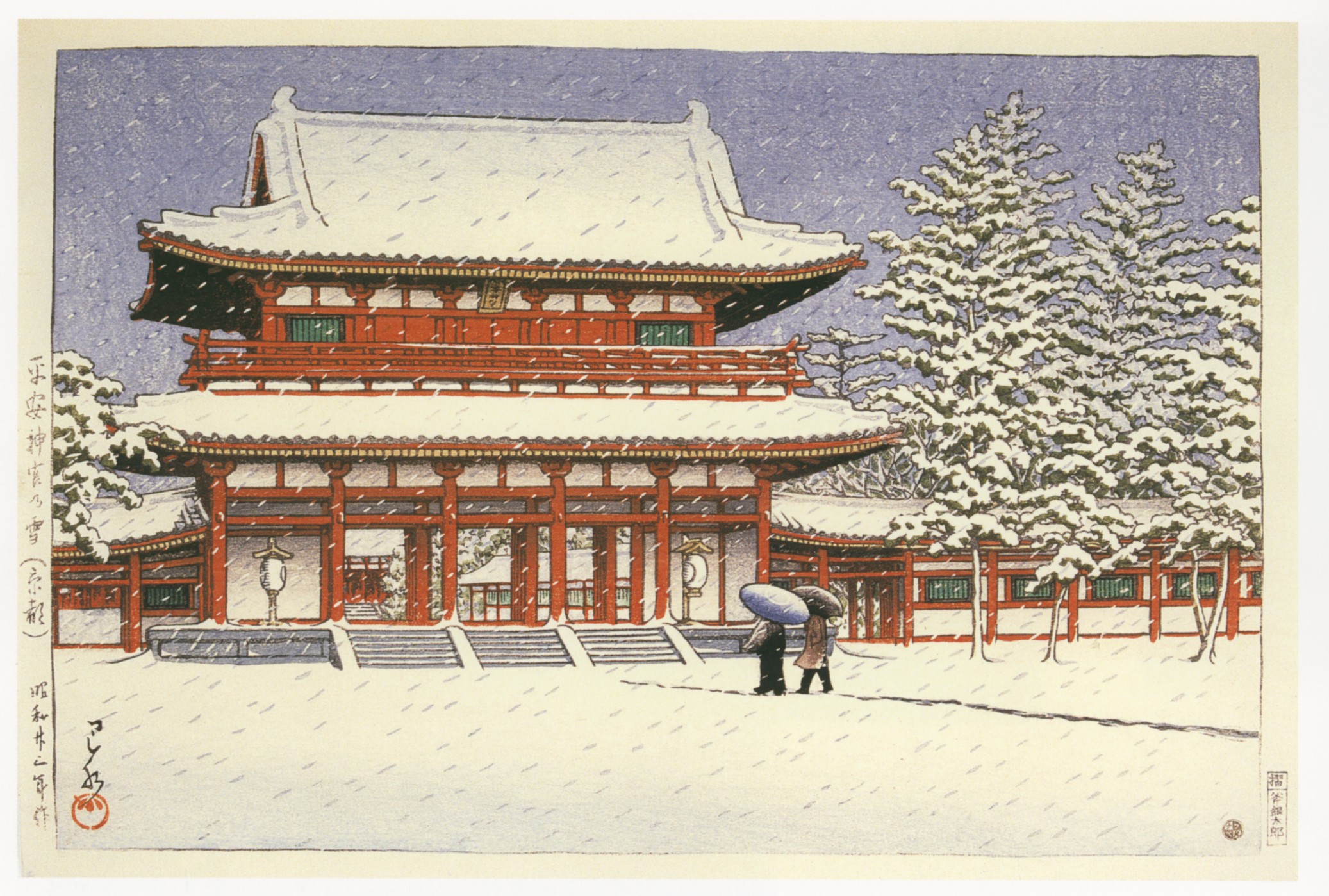About This Print
Catalogue Raisonné Entry
Source: Kawase Hasui; TheComplete Woodblock Prints, Kendall Brown, Amy Reigle Newland, Amsterdam, Hotei Publishing, KITPublishers, 2003, p. 123.The Heian shrine was built in 1894 to commemorate the 1100thanniversary of the founding of the city of Kyoto. It is dedicated tothe emperors Kanmu (r. 781-806) in whose reign the city wasestablished, and Komei (r. 1846-67), the last emperor in Kyoto. Thelarge garden was principally the work of Ogawa Jihei (1860-1933), whosedesign was inspired by the aesthetics of the Heian period (794-1185).
History of Heian Shrine
Emperor Kammu was born in 737 as thecrown prince of Emperor Konin and ascended to the throne in 781 as the50th Emperor of Japan. Realizing that the capital of Heijo was small inscale and beneath the dignity of our country, Emperor Kammu transferredthe capital to Nagaoka in the province of Yamashiro and, furtherpicking the adjoining districts of Kadono and Atago in 793 as the bestpossible site for the capital, began to construct a new palace. In thefollowing year, the seat of government was moved to the new capitalcalled the Heian Capital.
In 796, the Emperor held an audiencefor the first time at the Daigoku-den Palace at which dignitariescelebrated the New Year. This marked the beginning of Kyoto.
Duringhis 25 year reign, Emperor Kammu amended the laws and ordinances, gaverelief to the destitute, encouraged learning, innovated the domesticadministration, and opened the doors to foreign trade, therebycontributing to the development of the country. For more than 1,000years, until the Meiji Restoration, Kyoto prospered as the capital ofJapan.
The 50th ruler passed away in 806 and was entombed in the Kashiwara Mausoleum in Momoyama, Fushimi-ku, Kyoto.
Theyear 1895 happened to be the 1,100th year since the Heian Capital wasfounded. Marking this commemorative year, the citizens of Kyoto decidedto praise the virtues of Emperor Kammu and deify him as the ancestralgod of Kyoto. To this end, they created a shrine in the style ofChodo-in, the main edifice of the Heian Capital, dedicating it on March15th the same year.
Emperor Komei was born in 1831 as thecrown prince of Emperor Ninko and acceded to the throne in 1847 as the121st ruler of Japan. Though brief, his reign of 21 years marked theclosing days of the Tokugawa Shogunate and heralded the beginnings ofmodern Japan. Well cognizant of the turbulent times, the gifted rulerlaid the firm foundation of the Meiji Restoration. The Emperor passedaway on December 25, 1866 at the young age of 36. The end of his lifewas characterized by his intense patriotic concern for the welfare anddestiny of the country. The Imperial tumulus known as GotsukinowaHigashiyama Mausoleum is located at Sennyu-ji Temple, Higashiyama-ku,Kyoto.
In adoration of the great character and achievements ofthe Emperor who laid the foundation of modern Japan, the citizens ofKyoto organized an association to deify Emperor Komei at the HeianShrine in 1938. This propelled a move to rebuild the shrine as acommemorative project marking the 2,600th year of the founding ofJapan. The dedication ceremony took place on October 19, 1940.
Thisis how two Emperors of Japan, one the founder of and the other the lastruler of the Heian Capital, have come to be deified at Heian Shrine.Today, it does not only figure as a tourist attraction for foreignvisitors but also serves as the spiritual center of the nation as awhole, as well as of the patriotic citizens of Kyoto.
In 796, the Emperor held an audiencefor the first time at the Daigoku-den Palace at which dignitariescelebrated the New Year. This marked the beginning of Kyoto.
Duringhis 25 year reign, Emperor Kammu amended the laws and ordinances, gaverelief to the destitute, encouraged learning, innovated the domesticadministration, and opened the doors to foreign trade, therebycontributing to the development of the country. For more than 1,000years, until the Meiji Restoration, Kyoto prospered as the capital ofJapan.
The 50th ruler passed away in 806 and was entombed in the Kashiwara Mausoleum in Momoyama, Fushimi-ku, Kyoto.
Theyear 1895 happened to be the 1,100th year since the Heian Capital wasfounded. Marking this commemorative year, the citizens of Kyoto decidedto praise the virtues of Emperor Kammu and deify him as the ancestralgod of Kyoto. To this end, they created a shrine in the style ofChodo-in, the main edifice of the Heian Capital, dedicating it on March15th the same year.
Emperor Komei was born in 1831 as thecrown prince of Emperor Ninko and acceded to the throne in 1847 as the121st ruler of Japan. Though brief, his reign of 21 years marked theclosing days of the Tokugawa Shogunate and heralded the beginnings ofmodern Japan. Well cognizant of the turbulent times, the gifted rulerlaid the firm foundation of the Meiji Restoration. The Emperor passedaway on December 25, 1866 at the young age of 36. The end of his lifewas characterized by his intense patriotic concern for the welfare anddestiny of the country. The Imperial tumulus known as GotsukinowaHigashiyama Mausoleum is located at Sennyu-ji Temple, Higashiyama-ku,Kyoto.
In adoration of the great character and achievements ofthe Emperor who laid the foundation of modern Japan, the citizens ofKyoto organized an association to deify Emperor Komei at the HeianShrine in 1938. This propelled a move to rebuild the shrine as acommemorative project marking the 2,600th year of the founding ofJapan. The dedication ceremony took place on October 19, 1940.
Thisis how two Emperors of Japan, one the founder of and the other the lastruler of the Heian Capital, have come to be deified at Heian Shrine.Today, it does not only figure as a tourist attraction for foreignvisitors but also serves as the spiritual center of the nation as awhole, as well as of the patriotic citizens of Kyoto.
Print Details
| IHL Catalog | #30 |
| Title | Snow at Heian Shrine, Kyoto 平安神宮の雪(京都)Heian jingū no yuki Kyoto |
| Series | |
| Artist | Kawase Hasui (1883-1957) |
| Signature |  |
| Seal | Kawase seal (see above) |
| Publication Date | 1948 |
| Edition | This print possible first edition (with 6mm round "A"-type seal in lower right corner), but lacks the Ono Gintarō seal inthe lower right margin seen in the first edition image in the catalogue raisonné. (For a full discussion of Watanabe publisher sealssee "Watanabe Publisher Marks, Seals and Editions") |
| Publisher |  Watanabe "A"-type seal (in use from approximately 1918-1924 and 1945-1957) reading (in Katakana): ワタナベ Watanabe Shōzaburō |
| Impression | excellent |
| Colors | excellent |
| Condition | excellent - two small tape remnants verso from previous folio mounting |
| Miscellaneous | note the Ono Gintarō printer's seal in the right margin of the Catalog Raisonné print below right and its absence on the print in my collection. |
| Genre | shin hanga (new prints) |
| Format | ōban tate-e |
| H x W Paper | 10 1/2 x 15 5/8 in. (26.7 x 39.7 cm) |
| H x W Image | 9 1/2 x 14 1/4 in. (24.1 x 36.2 cm) |
| Collections This Print | Virginia Museum of Fine Arts 2006.512 (identical to this collection's print) |
| Reference Literature | CatalogueRaisonné: Kawase Hasui; TheComplete Woodblock Prints, Kendall Brown, Amy Reigle Newland, Hotei Publishing, KITPublishers, 2003, p. 123, pl. 510; Visions of Japan: Kawase Hasui's Masterpieces, Kendall H. Brown, Hotei Publishing, 2004, p. 124, pl. 88. |
8/19/2021




